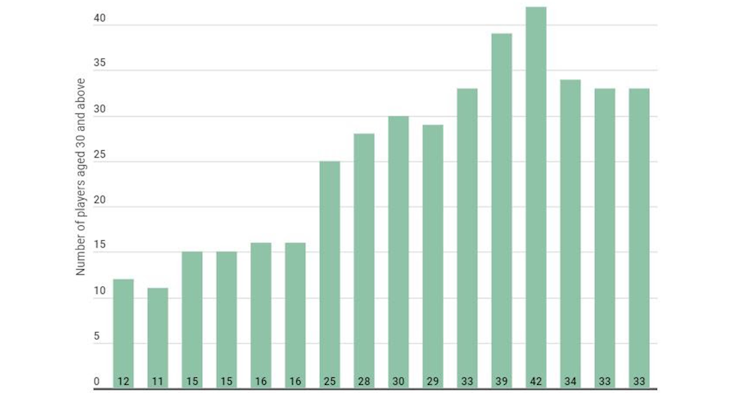Better with Age: The Genius Of The Big Three
Last updated: Aug 24, 2020, 4:21AM | Published: Aug 21, 2020, 12:24AM
Michael Chang won his first ever Grand Slam at the tender age of 17. So did Boris Becker. Rafael Nadal won the first of his 12 French Opens at 18, while Pete Sampras won the US Open at 19. Marat Safin and Lleyton Hewitt were both 20 when they won the US Open.
As little as 20 years ago, it wasn't difficult to imagine a youngster doing well on the biggest stage, yet the thought of a teenager triumphing in today's environment is almost impossible.
Roger Federer, Rafael Nadal, and Novak Djokovic - at the age of 38, 34, and 33 respectively, continue to completely dominate the ATP tour.
In fact, it's been almost two decades since the dominance of the ‘Big Three.’
In the 2000s, it was Federer and Nadal, and in the past decade, it's been Serbia's Djokovic who's taken matters into his own hands, amassing 17 Grand Slam titles and in firm possession of the world #1 mantle.
RELATED: Explore Stats Insider's Own In-House World Rankings
However, apart from the big three, men's tennis has seen a jolt in the amount of players performing significantly better as they've grown older.
America's John Isner won his first ever Masters title in Miami in 2018 at the age of 33, then reached the semi-final of his first ever Grand Slam at Wimbledon a few months later.
Kevin Anderson reached his first Grand Slam final in 2017 at the age of 31.
Other players like Spain's Roberto Bautista Agut and Albert Ramos-Vinolas, Tennessee's Tennys Sandgren and Argentina's Guido Pella to just just to name a few, have been getting brilliant results into their thirties or upon the onset of an age usually associated with decline.
In recent years, there's been little doubt the average of the ATP Top-100 has been gradually increasing.
A study done by 'Tennis Head' revealed that the average age of the men’s top-100 at the end of 2018 was 28.26, when compared to 23.74 thirty years ago.
One of the reasons for the increase is that the sport has become a lot more physically demanding than it was, say in the 1990s or the early 2000s.
In an interview with Tennis Head, current world #17, Stan Wawrinka spoke about the physical nature of the game.
“We are taking better care of our bodies. We’re working harder. It’s not only in tennis. You see it in every sport – in NBA, in soccer, players have started to play longer,” Wawrinka said.
It’s not just the average age of the top 100, but the average age of Grand Slam winners has been increasing too.
In fact, the average age of the Top-Four itself has been gradually increasing over the years.
RELATED: Who Has The Most To Gain When The ATP Season Resumes?
If we were to look at the previous decade, the average age of the Top-Four in 2010 was 24.75, indicating that youngsters were performing well.
However if we are to look at the Top-Four in 2020 so far, the average age is 32.25, illustrating the vice-like grip of seniority on tour.
Hence, one could say that tennis players are getting better by age, and that the ‘peak age’ has increased from what it was ten years ago.
However, if we look at who the Top-Four of 2010 and 2020, three out of the four players are the same.
Similarly, if we were to look at the grand slam winners over the past 15 years or so, the same three names pop up on most occasions- Federer, Nadal, and Djokovic.
Since 2004, there have been only 8 occasions when a player apart from the Big Three won a Grand Slam; Andy Murray and Stan Wawrinka won three each, while Argentina's Juan Martin Del Potro won the US Open in 2009, while Croatia's Marin Cilic saluted at the same event five years later.
Since Federer took over as the world #1 in 2003, and after winning his first ever Wimbledon title, there have been only 41 weeks where neither one of the ‘Big Three’ topped the rankings, with Andy Murray the only player enjoying the view from the top.
The 'Big Three' have dominated on each surface, with Federer doing so on grass and hard courts (8 titles at Wimbledon, 7 in Melbourne, 5 at the US Open), Nadal has completely dominating on clay (13 titles at Roland Garros), while Djokovic has performed best on hard courts where 12 of his Grand Slams have been claimed at either the Australian Open or Flushing Meadows.
The fact that each of them have produced great results on different surfaces has prevented multiple generations of players stepping up and finding a gap in the market to assert their authority.
With the US Open looming this week, and with neither Federer nor Nadal taking part, this might present a golden opportunity for one of the ‘Next Gen’ players to break the jinx of the Big Three, and perhaps usher in a new era of tennis.
However, with Djokovic taking part, he might just have the last laugh and win his 18th Major and only entrench his focus on sporting immortality.
Did you enjoy this article? Join our free mailing list to get the best content delivered straight to your inbox, or join the conversation by leaving a comment below or on the Stats Insider Twitter or Facebook page.




